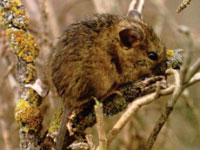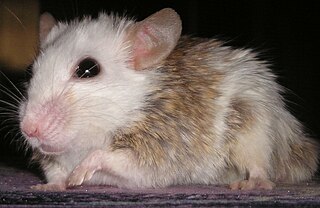
Chevrotains, or mouse-deer, are diminutive, even-toed ungulates that make up the family Tragulidae, and are the only living members of the infraorder Tragulina. The 10 extant species are placed in three genera, but several species also are known only from fossils. The extant species are found in forests in South and Southeast Asia; a single species, the water chevrotain, is found in the rainforests of Central and West Africa. In November 2019, conservation scientists announced that they had photographed silver-backed chevrotains in a Vietnamese forest for the first time since the last confirmed sightings in 1990.

The rodent subfamily Sigmodontinae includes New World rats and mice, with at least 376 species. Many authorities include the Neotominae and Tylomyinae as part of a larger definition of Sigmodontinae. When those genera are included, the species count numbers at least 508. Their distribution includes much of the New World, but the genera are predominantly South American, such as brucies. They invaded South America from Central America as part of the Great American Interchange near the end of the Miocene, about 5 million years ago. Sigmodontines proceeded to diversify explosively in the formerly isolated continent. They inhabit many of the same ecological niches that the Murinae occupy in the Old World.

The salt-marsh harvest mouse, also known as the red-bellied harvest mouse, is an endangered rodent endemic to the San Francisco Bay Area salt marshes in California.

Apodemus is a genus of Muridae. The name is unrelated to that of the Mus genus, instead being derived from the Greek ἀπό-δημος.

Reithrodontomys is the genus of groove-toothed New World harvest mice.
The aquatic rat, Ecuador fish-eating rat, fish-eating rat or Ecuadoran ichthyomyine is a South American species of semiaquatic rodent in the family Cricetidae. It is the only species in the genus Anotomys. This species is currently considered endangered. It is thought to be nocturnal and feeds on aquatic arthropods and insects. It is found in small ranges along the Andes.
The Chibchan water mouse is a species of rodent in the family Cricetidae. It is found in the Andean highlands of Colombia, Peru, and Venezuela. Its natural habitats are tropical cloud forests and streams at elevations from 2500 to 2700 m. It feeds on snails and possibly small fish.
Habromys is a genus of rodent in the family Cricetidae, found in Mexico and Central America. It contains these species, all but one of which are threatened or endangered, five of them critically so. H. lophurus is near threatened.

Mastomys is a genus of rodent in the family Muridae endemic to Africa. It contains eight species:

Nectomys is a genus of rodent in the tribe Oryzomyini of family Cricetidae. It is closely related to Amphinectomys and was formerly considered congeneric with Sigmodontomys. It consists of five species, which are allopatrically distributed across much of South America: Nectomys grandis in montane Colombia; Nectomys palmipes on Trinidad and in nearby Venezuela, Nectomys apicalis in the western margins of the Amazon biome, Nectomys rattus in much of Amazonia, and Nectomys squamipes in the Atlantic Forest of Brazil. These species are generally semiaquatic, are normally found near water, and are commonly called water rats.
Nectomys rattus, the small-footed bristly mouse, Amazonian nectomys, Amazonian mouse, or common water rat is a species of rodent in the genus Nectomys of family Cricetidae. It is found in Brazil, Colombia, French Guiana, Guyana, Suriname, and Venezuela, where it lives in a variety of habitats including lowland tropical rainforest, cerrado and caatinga. It is mainly found in areas close to water. It was recognized as distinct only in 2000 and its limits with other Nectomys, including Nectomys apicalis and Nectomys squamipes, remain unclear.

Bolam's mouse is a species of nocturnal, burrowing rodent in the family Muridae that inhabits the semi arid and southern arid regions of Australia. It has a number of physiological and behavioural adaptations developed to cope with an extremely varied climate. Including the ability survive by extracting water from seeds alone, the production of highly concentrated urine, low water content faeces and nocturnal activity.
The country mouse also known as the pebble-mound mouse or eastern pebble mound mouse is a species of rodent in the family Muridae. It lives only in Australia, where it is considered rare. It was described by Thomas and Dollman in 1909.
The Mexican water mouse, Mexican fishing mouse or Goodwin's water mouse, is a species of semiaquatic rodent in the family Cricetidae. It has a restricted range in the state of Oaxaca in southern Mexico, Threatened by deforestation and water pollution, it is listed as Endangered by the International Union for Conservation of Nature (IUCN).
Rheomys is a genus of Mexican and Central American semiaquatic rodents in the family Cricetidae.
Underwood's water mouse is a species of rodent in the family Cricetidae. It is found in Costa Rican and western Panamanian cloud forest at altitudes from 1500 to 2000 m. This mouse lives near streams in highland forests and is semiaquatic; its carnivorous diet includes invertebrates. Although its range is small, it includes a number of protected areas, and the population appears to be sizable; the IUCN therefore rates the conservation status of the species as "least concern".

Xeromys myoides, also known as the water mouse, marine mouse, mangrove mouse, false water rat, manngay and yirrkoo, is a species of rodent native to waterways of Australia and Papua New Guinea.
German's one-toothed moss mouse is a species of rodent in the family Muridae which occurs in the mountains of southeastern New Guinea.
Water mouse can refer to several types of not closely related semiaquatic rodents of superfamily Muroidea:







